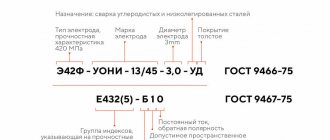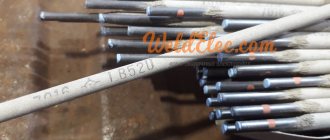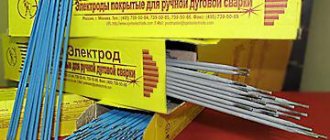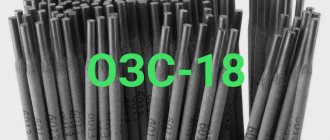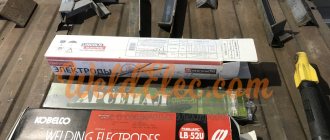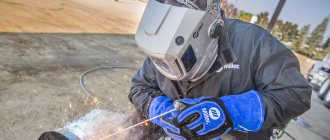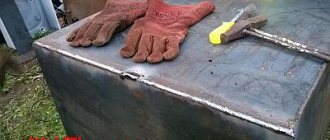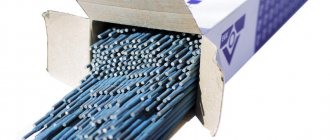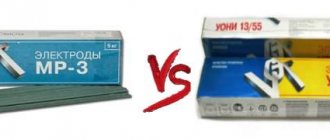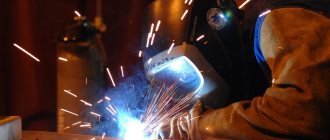Various electrodes are used to weld metal parts. The most common are SSSIs. The reason for this popularity is their versatility, as well as the fact that they are used for welding low-alloy steels. But most metal products are made from steel with a low degree of alloying.
What is a welding electrode in general? It consists of a metal rod, which is actually the material for filling the seam between the parts being welded. A special coating made of flux with the addition of certain elements is applied to it. For example, in an SSSI these elements are nickel and molybdenum.
Why is coating needed?
During combustion, the core metal takes oxygen and other substances from the atmosphere, which, when mixed, adversely affect the quality of the weld. It is necessary to remove them to the slag, preventing them from getting into the metal. This is why coating is needed. Here are specially selected materials that, when mixed with substances harmful to steel, combine with them.
This connection is lighter and when the seam hardens, it is brought to the surface into a slag crust. Thanks to this crust, the porosity of the seam is eliminated, which increases the strength and reliability of the connection. And this is considered the main point when welding metal parts.
Why SSSI electrodes are most in demand
A distinctive feature of electrodes of this brand is that they can be used at low temperatures. The main problems arise when the seam cools, and when it cools quickly, cracks, shrinkage cavities and other defects may appear. Subsequently, they will lead to the fact that the welded parts will simply separate from each other.
High quality, as well as the absence of defects during hardening, is due to the fact that the chemical composition of the resulting seam assumes sufficiently high ductility and impact strength. This will extend the life of this connection in the future, especially if the welded parts are intended to be used in harsh and frosty climates.
It is precisely on the basis of these useful properties and qualities that SSNI electrodes have gained such high popularity among users.
It is worth noting that this connecting material is considered more professional than, for example, ANO. Therefore, it will be quite difficult for an ordinary person to work using this brand.
Popular varieties
Consumables of this type are produced in a wide range of diameters (from 2 to 5 millimeters). The most popular in the model range are UONI 13 55 3mm and 4mm electrodes. At the same time, there are four types of products that have a specialized purpose and their own specific application.
- 13/45 – designed for creating highly demanding metal structures from low/medium carbon steel blanks. They are also used to repair cast and forged products and eliminate defects. The core of these electrodes contains molybdenum and nickel, which provide the weld with the necessary toughness and ductility.
- 13/55 – focused on welding structural elements made of low/high carbon steels. The coating of such models contains phosphorus, sulfur, silicon and manganese, which guarantees excellent quality of the welded joint. Used in production workshops. The products are demanding on the condition of the parts (dirt, rust and moisture on their surface).
- 13/65 - used in the same cases as analogues 13/55. These electrodes are used to produce a seam of improved quality, but the price of such SSSI per kg is noticeably higher. Therefore, such consumables are used only when creating especially critical metal structures and products.
- 13/85 - the most expensive welding electrodes from the UONI model range. They are actively used in the process of forming structures from parts made from alloy steels.
Technical characteristics of SSSI
Among the many parameters that relate to the properties of electrodes, the most important are:
- coating – basic;
- surfacing productivity – 1.4 kg/h;
- the cost of surfacing one kilogram is 1.7 kg;
- current – constant;
- polarity is reversed.
It is worth noting that this type of electrodes has an internal additional classification. There are 4 groups in total:
- SSSI 13-45. Most often used to connect parts that were made by casting or forging. The seams are plastic and also have a fairly high viscosity.
- SSSI 13-55. This type of electrode is also intended for welding parts made of low-alloy steels, but with a high carbon content. A distinctive feature is that this brand cannot be used when welding a seam from top to bottom. A composite material consisting of sulfur, manganese, silicon and phosphorus is used as coating. The use of such electrodes contributes to the production of a high-strength weld with high resistance to the formation of cracks and fractures.
- SSSI 13-65. They can be used for particularly critical work, as well as on those metal structures for which increased quality requirements are put forward. According to GOST, these electrodes are produced with diameters of 2 mm, 3 mm, 4 mm and 5 mm. Regardless of whether it will be the manufacturer ESAB, LEZ or some other. Different manufacturers may offer their products at different prices, and this will be the difference. It is worth noting that an increase in thickness inevitably entails an increase in current strength. Therefore, those using an inverter may be a little limited as weaker models may not be able to produce the required amount of current.
- SSSI 13-85. Allows you to work with metal structures of increased strength, including those made of alloy steel. Like model 13-65, they can be used when welding parts in all spatial directions.
SSSI or SSII?
On sale you can find products with both labeling options. In fact, they have the same purpose, but differ significantly in price and quality. What is the reason for this unusual situation?
Returning to the question of the state standards used, it is worth noting that the main document in this case is GOST 9466-75. Both of the above types of products fully comply with it, however, UONII electrodes undergo additional certification by NAKS.
NAKS is the National Welding Control Agency, which has developed and issued additional guidance documents - RD 03-613-03. They can be considered a full-fledged addition to the existing GOST, which significantly tightens the requirements for the use of welding materials.
Thus, despite compliance with GOST, UONI 13 electrodes are of lower quality than products marked UONII, and, as a result, do not give such an outstanding result during operation.
You can distinguish products by the markings on the box.
SSSI marking and explanation of the main parameters
To distinguish electrodes of even the same brand from each other, they came up with additional markings that determine their purpose. For example, what could the marking e50a or simply e55 mean? Having a special table at hand, you can easily determine what is what and how these names differ.
So, the letter “e” means that this is an electrode designed for manual arc welding. The number 50 is the limit of strength of the connection obtained when used correctly. The letter "A" is used to represent a seam. She says that the seam will be plastic and can easily withstand high impact loads.
This is followed by the name of the SSNI electrodes themselves, after which additional markings are placed, for example, 13-55 or 13-85. After this, the diameter of the steel core is indicated. It is worth noting that it is indicated with an accuracy of tenths of a millimeter. That is, if it’s a 5, then it’s 5.0, if it’s a 4, it’s 4.0, and so on.
At the very end there is a letter “U”, which indicates that this type of electrode is used for welding carbon steels.
Electrodes UONI-13/55 DC GOST 9466-75
| Catalog / welding electrodes UONI-13/45, UONI-13/55 |
Electrodes UONI 13/55 GOST 9466-75 are intended for:
- for welding structures made of steel grades 10ХСН2Д, 48КS.
- for welding the listed steel grades with steel grades St3, BSt3, 09G2, 10G2S1D-35, 10G2S1D-40, 10HSND, MS-1, St3s, 10, 15, 20 and forgings made of carbon and dispersion-hardened steels, as well as for welding castings and forgings with each other, when increased demands are placed on the metal of the welded seams in terms of ductility and impact toughness.
Type of current - constant.
Electrodes about 2015
The quality of UONI welding electrodes has been confirmed:
- fill out the simple “Place an order” form at the top of the page;
- call on the phone +7;
- send your application by email;;
Buy electrodes. Purpose and length of SSNI electrodes:
| Electrode brand | Electrodes UONI-13/55 | GOST 9466-77, TU1272-175-00187211-97 | |
| Purpose: | For welding particularly critical structures made of carbon and low-alloy steels. Recommended for welding structures operating at low temperatures | ||
| Diameter, mm | 2,0 | Length, mm | 250; 300 |
| Diameter, mm | 2,5 | Length, mm | 300; 350 |
| Diameter, mm | 3,0 | Length, mm | 350 |
| Diameter, mm | 4,0 | Length, mm | 450 |
| Diameter, mm | 5,0 | Length, mm | 450 |
Mechanical properties of UONI electrodes:
| Electrode brand | Mechanical properties, no less | ||||
| weld metal | welded joint | ||||
| tensile strength, MP (kgf/mm2) | relative extension, % | impact strength, J/cm2 (kgf/cm2) | tensile strength, MP (kgf/mm2) | Bend angle, degrees. | |
| 13/45 | 410(42) | 22 | 147(15) | 410(42) | 180 |
| 13/55 | 490(50) | 20 | 127,4(13) | 490(50) | — |
| 13/45(A) | 430-530(44-54) | 26 | 160(16) | 430-530 | 180 |
Chemical composition of electrodes (%):
| Mass fractions of elements, % in deposited metal | ||||||
| carbon, no more | silicon | manganese | nickel | molybdenum | sulfur, no more | phosphorus, no more |
| 0,11 | 0,12-0,25 | 0,35-0,70 | — | — | 0,030 | 0,035 |
Type of current, position of the seam in space during welding:
| Rod current | Seam position in space |
| DC current, reverse polarity |
Welding current, electrode consumption coefficient during welding:
| Diameter, mm | Welding current, A | Electrode consumption coefficient per 1 kg of deposited metal | Surfacing capacity, g/A. hour | ||
| lower | vertical | ceiling | |||
| 2,0 | 40-60 | 35-55 | 35-55 | 1,65 | 9-10 |
| 2,5 | 50-70 | 40-65 | 40-65 | 1,65 | 9-10 |
| 3,0 | 80-100 | 70-90 | 70-90 | 1,65 | 9-10 |
| 4,0 | 130-150 | 130-140 | 130-140 | 1,65 | 9-10 |
| 5,0 | 170-200 | 160-180 | — | 1,65 | 9-10 |
Coverage type: basic.
How to buy UONI-13/55 DC electrodes GOST 9466-75 at low prices:
Delivery within the Russian Federation: Moscow, St. Petersburg, Arkhangelsk, Astrakhan, Barnaul, Belgorod, Bryansk, Vladimir, Volgograd, Vologda, Voronezh, Yekaterinburg, Ivanovo, Izhevsk, Yoshkar-Ola, Kazan, Kaluga, Kirov, Kostroma, Krasnodar, Kurgan, Kursk, Lipetsk, Omsk, Orenburg, Penza, Perm, Pskov, Rostov-on-Don, Ryazan, Samara, Saransk, Saratov, Sevastopol, Simferopol, Smolensk, Stavropol, Tambov, Tver, Tomsk, Tula, Tyumen, Ulyanovsk, Ufa, Chelyabinsk, Yaroslavl, etc.
The information presented on this website contains a catalog of reference information on more than 3,000 types of metal products, is for informational purposes only, and can be used in various areas of enterprise activity.
| Steel wire Welding electrodes Steel rope Fasteners | Metal mesh Hex bolts Nut GOST, DIN Steel rivets | Adjustable cotter pins GOST, DIN washers Threaded rods Calibrated rolled products | Slings, rigging Construction nails Steel cable Screws GOST, DIN |
Additional markings
In addition, other designations may be used:
- T – welding can be performed with thermally resistant metals;
- B – welding of high-alloy steels is possible;
- N - this letter means that these electrodes can be used for surfacing the surface of the part (in case of restoration of its geometry or design dimensions);
- L - such electrodes can be used when welding alloy steels.
It turns out that an experienced welder, looking at a pack with markings, descriptions or a product certificate, can immediately understand what these electrodes are intended for. In addition, it will be clear how effective their use is in a particular job. It is recommended not to violate the technology in any way, then the welded elements will last for a long time without the need for repair or replacement.
Storage
To get a good quality weld, it is not enough to know how to choose electrodes and how to weld metal with them. It is also necessary to store the rods correctly.
Ideally, electrodes should be stored in a separate room specifically designed for long-term storage. Such a room must have dry air and heating. The air temperature should not fluctuate, the optimal value is +15 degrees. To achieve such conditions, it is necessary to use an air conditioning system.
If the room is underground, then it is necessary to make high-quality waterproofing. To prevent excess moisture from penetrating into the warehouse. But we all understand that it is almost impossible to achieve such conditions in a garage or apartment. So how can you achieve good storage without breaking the bank?
First of all, try to store the electrodes in a constantly heated room. If you close the garage for the winter and do not visit it until spring, then it is better to take the electrodes home and store them in a dark, dry place. Let it be the mezzanine and the top shelf of the closet. If you have a heated garage, then make sure that the electrodes are stored in a special case. You can make it yourself from a piece of small diameter plastic pipe. Never store electrodes on open ground or grass. Even if they are in a box. And in general, do not think of the box as a storage place; they are short-lived and unreliable. Packaging is intended for transportation only.
If you nevertheless violated the storage rules and the electrodes became saturated with moisture, then heat them in an electric oven for an hour. If the electrodes crumble, then nothing can be done about it. Re-read the storage rules and avoid mistakes.
Pros and cons of SSSI
The useful properties of these electrodes were described in detail in the previous paragraphs, so we will specifically focus on the disadvantages. In fact, there are almost none except that some types of SSSI cannot be used in top-down welding. Troubles can also arise due to moisture that is absorbed into the coating.
But, despite the fact that this is a very significant drawback that prevents the arc from burning correctly and the seam from laying evenly, it is very easy to deal with. This can be corrected by calcination. This is the process of heating the rods and coating in an oven at a certain temperature.
Features of SSSI calcination
- It is important to heat the oven to 250-280 degrees, and also to ensure uniform calcination of the electrodes. This is achieved using special containers.
- It is forbidden to keep the electrodes in the oven for more than 4 hours, or to calcinate them more than three times.
- After calcination, the electrodes should be used within 8 hours. After this time, the event should be repeated.
If everything is done correctly and clearly, without violating technology, the quality of the seams will be at the highest level. The welder will receive a stable arc without the electrode sticking to the surface of the parts being welded.
Reviews
Egor. While working at a metallurgical plant, I managed to stock up on many SSSI electrodes for various purposes, including MR ones. As they say, there is everything for all occasions. I don’t use it very often, but no matter how much time has passed, they still work and work without problems. Quality is QUALITY in Africa too!
Anatoly. I welded with electrodes at a SSSI in the north, worked in Magadan, even in severe frost you light an arc and everything burns normally. And the seam is plastic and even with rapid cooling it does not warp or break. In 10 years it will be a solid monolith, no cracks or chips, I guarantee it. Now I have an inverter welder, if I need to weld something, I use only SSSI.
Vladislav. It’s convenient that a pack of electrodes is 5 kg, so you don’t need to constantly print it out if you’re working. In short, don't get distracted. I got an internship as a welder and am now learning the skills. I practice, improve, learn to select the brand that is best suited. I have already mastered the bulk of electrodes - now I am studying with SSSI. True, at school they said that they were the hardest to cope with.
How do UONI electrodes differ from MP-3?
Below you will be presented with the main differences between UONI electrodes and MP-3:
Coating type : MP-3 electrodes have a rutile coating. Rutile is a good conductor of electric current, so all rutile electrodes have easy arc ignition. They ignite well and re-ignite, which cannot be said about electrodes with a basic coating.
In turn, SSSI electrodes have exactly the basic type of coating. Therefore, the first difference between UONI electrodes and MP-3 electrodes is the type of coating.
Welding current : both alternating current and direct current are suitable for welding with MP-3 electrodes. In addition, you can cook with rutile electrodes in any polarity. The same cannot be said about the SSSI electrodes. They can only be cooked using direct current of reverse polarity .
Many novice welders are faced with the main problem when welding with UONI electrodes; they do not know what current and what polarity is needed.
Working conditions : MP-3 electrodes can weld rusty and dirty metal, that is, poorly prepared for welding. Rutile electrodes ignite well, which cannot be said about the main electrodes. Just as mentioned above, MP-3 electrodes are less sensitive to moisture than UONI electrodes.
